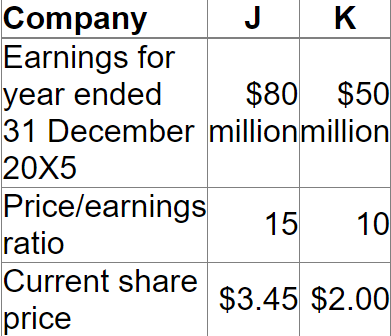CIMA F3 - Financial Strategy
A major energy company, GDE, generates and distributes electricity in country A. The government of country A is concerned about rising inflation and has imposed price controls on GDE, limiting the price it can charge per unit of electricity sold to both domestic and commercial customers. It is likely that price controls will continue for the foreseeable future.
Â
The introduction of price controls is likely to reduce the profit for the current year from $3 billion to $1 billion.
Â
The company has:
   • Distributable reserves of $2 billion.Â
   • Surplus cash at the start of the year of $1 billion.Â
   • Plans to pay a total dividend of $1.5 billion in respect of the current year, representing a small annual increase as in previous years. However, no dividends have yet been announced.Â
Â
Which THREE of the following responses would be MOST appropriate for GDE following the imposition of price controls?
A company needs to raise $20 million to finance a project.
It has decided on a rights issue at a discount of 20% to its current market share price.
There are currently 20 million shares in issue with a nominal value of $1 and a market price of $5 per share.
Â
Calculate the terms of the rights issue.
An unlisted software development business is to be sold by its founders to a private equity house following the initial development of the software. The business has not yet made a profit but significantprofits are expected for the next three years with only negligible profits thereafter. The business owns the freehold of the property from which it operates. However, it is the industry norm to lease property.
Which THREE of the following are limitations to the validity of using the Calculated Intangible Value (CIV) method for this business?
Which of the following statements is true of a spin-off (or demerger)?
Extracts from a company's profit forecast for the next financial year is as follows:

Since preparing the forecast, the company has decided to return surplus cash to shareholders by a share repurchase arrangement.
The share repurchase would result in the company purchasing 20% of the 2,000 million ordinary shares currently in issue and cancelling them.
Assuming the share repurchase went ahead, the impact on the company's forecast earnings per share will be an increase of:
X exports goods to customers in a number of small countries Asia. At present, X invoices customers in X's home currency.
The Sales Director has proposed that X should begin to invoice in the customers currency, and the Treasurers considering the implications of the proposal.
Which TWO of the following statement are correct?
Company J is in negotiations to acquire Company K and believes it can turn around Company K's performance to match its own.
Â
The following information is available for the two companies:
Â
  
Â
Select the maximum price for each share that Company J should place on Company K during negotiations.Â
Which THREE of the following prevent the Purchasing Power Parity Model from operating effectively in practice?
XYZ is a multi-national group with subsidiary AA in Country A and subsidiary BB in Country B. The capital structures of AA and BB are set up to take advantage of the lower tax rate in Country A Thin capitalisation rules in Country B will limit the ability for either AA or BB to claim tax relief on:
Company A is proposing a rights issue to finance a new investment. Its current debt to equity ratio is 10%.
Â
Which TWO of the following statements are true?



